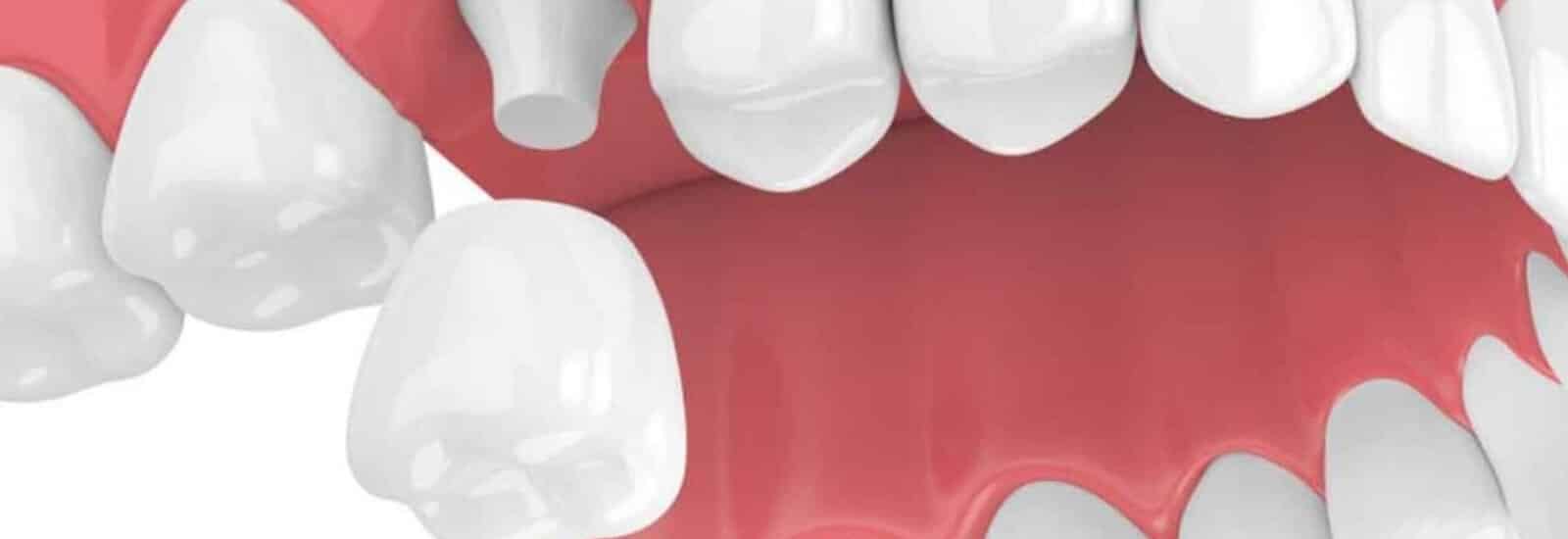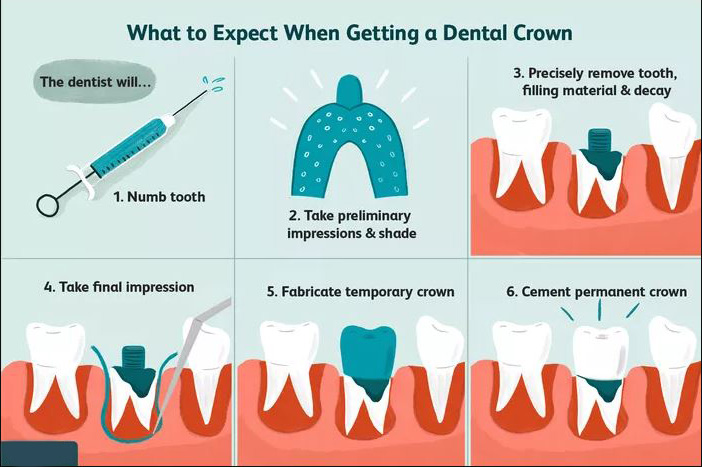Dental Crowns Treatment and Cost in Surat
A tooth-shaped cover that is placed over the tooth is called a dental crown. It is usually put after the root canal treatment where the infected pulp and cavity are cleaned. Dental crown further protects the tooth from any damage. At Surat, you can find one of the finest dental crown treatments at the Sabka dentist branch at a very affordable cost.

Talk to a Dentist Now!
Crowns can be made ahead of time (prefabricated) or made to order in a laboratory. Prefabricated crowns are made of plastic or stainless steel. They can be used on a temporary basis until a permanent crown is made.
Crowns can be all metal, porcelain fused to metal (PFM), or all ceramic. Metals include gold alloy, other alloys (palladium) or a base-metal alloy (nickel or chromium). The all-metal or PFM crowns are stronger and are better choices for back teeth than ceramic crowns. PFM and all-ceramic crowns are the same color as your natural teeth. They look just like normal teeth.
Crowns usually last at least seven years. In many cases, they last much longer, up to 40 years or so.

How is the Tooth prepared?
If you need a crown, you may also need endodontic or root canal treatment on the tooth. Such treatment may be recommended if you have a lot of decay in the tooth. This increases the risk of infection or injury to the tooth’s pulp. Not everyone who needs a crown will also need a root canal.
Before placing a crown, your dentist may need to build up a foundation to support it. A foundation is needed if large areas of the tooth are decayed, damaged or missing. If you are receiving the crown after root canal treatment, your dentist may insert a post-and-core foundation. In most cases, after the root canal treatment and the post and core, a filling will be required.
To place a crown, your dentist will file down the tooth to make room for the crown. If you are receiving an all-metal crown, less of the tooth needs to be removed because these crowns can be made thinner than PFM or ceramic ones.
After filing down the tooth, there are two ways to make a permanent crown. Most crowns require two visits to the dentist. You receive a temporary crown at the first visit and wear it while your permanent crown is made. Some dentists have a machine that makes a crown in one visit.
With the traditional approach to making a crown, your dentist first will use a piece of thread or cord to push the gum away from the tooth. Then the dentist will make an impression (copy) of the tooth using a rubber-like material. The impression material sets in about five minutes. Then it is removed.
Your dentist will also take an impression of the teeth above or below the tooth that will receive the crown. The purpose is to make sure the crown will fit into your normal bite.
The impressions are sent to the lab, where the crown is made. During that time, you will have a temporary crown placed. These crowns are usually made of plastic. They can be made in advance by the laboratory or made by the dentist during your preparation visit. Then the dentist fits the temporary crown to your tooth.
These crowns are not meant to last for a long time. In some cases, however, a temporary crown can stay in place for a year or longer. If it needs to last longer, a lab-made plastic crown is best. It is stronger and will last longer than a temporary plastic crown that is made by the dentist.
Temporary cement is used to keep this crown in place. It is a special cement that is designed to be weak. This allows your dentist to easily remove the temporary crown so your permanent crown can be placed.
At a second visit, your dentist will remove the temporary crown and test the permanent one. Sometimes crowns need more polishing or glazing or some other adjustment before they are placed. Once the crown is ready, it is permanently cemented on your tooth.
What care should be taken after crown placement?
You shouldn’t feel any discomfort or sensitivity after a crown is placed. However, if your tooth has not had a root canal it will still contain the nerve. You may, therefore, have some temporary sensitivity to cold. If you notice pain or sensitivity when you bite down, contact your dentist. Usually, this means that the crown is too high. This can be adjusted easily.
You may notice a thin, dark line next to the gumline on your crowned tooth if you look very closely in the mirror, particularly if you have a PFM crown. This dark line is the metal of the crown showing through. This is not a concern unless it appears on your front teeth and is visible. An all-porcelain crown, with no metal base, may be required to replace this crown.
A crowned tooth is protected from decay, except for the gum line. Your dentist may prescribe a high-fluoride gel for you to use every night if you have a high risk of developing cavities. A crown does not protect against gum disease. You should continue to brush twice a day and floss daily.
Crowns, especially all-porcelain ones, can chip. This can sometimes be repaired in the mouth. Your dentist will etch the porcelain with a special agent and then bond a composite resin to it to fix the chip. Porcelain repairs often don’t last long. If there’s a lot of chipping, you may need a replacement crown.
If the crown does not fit well over the prepared tooth, it’s possible that the cement will wash out from under the crown. However, the crown may not fall out right away. Under these conditions, bacteria will leak in and cause decay. If your crown seems loose when you chew, or if you have an unusual odor around the tooth, discuss this with your dentist. Your dentist will check your crowns at your regular visits.
Crowns sometimes fall out. This can be caused by washed-out cement or an improper fit. If this happens, place the crown in a secure, zip-top plastic bag. Then bring it to your dentist. Most of the time a new crown needs to be made. The old crown can be used as a temporary crown.
If you are in no discomfort and your appearance is not affected, don’t try to put the crown back in place yourself. If you do need to put it back in your mouth, clean it well on the inside. Use a toothpick to loosen and remove any cement or debris that is stuck to the crown. A wet cotton swab can finish the cleaning. You can replace the crown temporarily using denture adhesive or temporary cement. This is sold in many pharmacies. Contact your dental office right away and try to schedule a visit for the next day.
If you are away from home, seek a dentist in the area who can evaluate the problem.
About Author

Dr. Priyanka graduated in 2008, obtained her BDS degree from the faculty of dentistry at the Maharashtra University of Health Sciences. Upon graduating, she was selected to complete a multi-disciplinary hospital residency at Government Dental College and Hospital, Mumbai. This residency provided her with advanced training in all the specialties of dentistry. Dr. Priyanka then moved to private practice, working as an associate dentist.
Dr. Priyanka has a diploma in Soft Tissue Lasers from IALD and fellowship in Implant & Esthetic Dentistry. Dr. Priyanka completed MBA in Hospital Management and Clinical Research. She has worked at Sabka Dentist since 2012 and is pleased to say that their advanced technology allows dentists like her to provide patients with painless, gentle dentistry and a pleasant experience.








